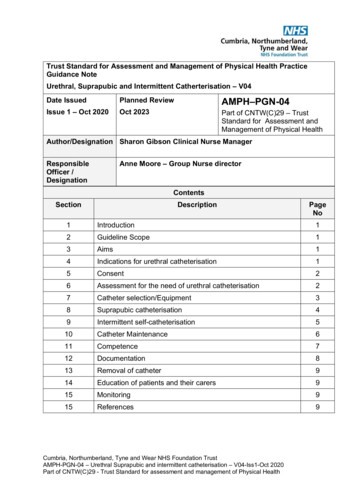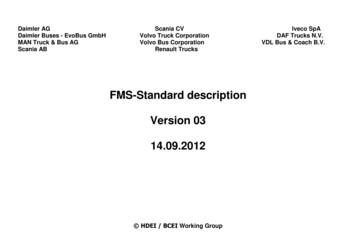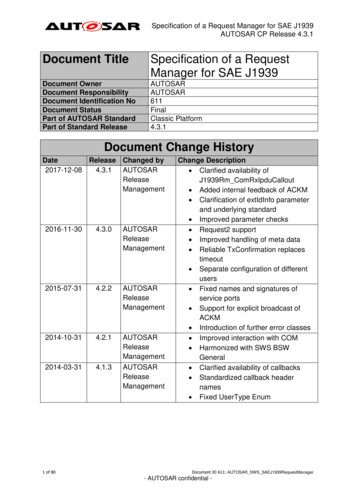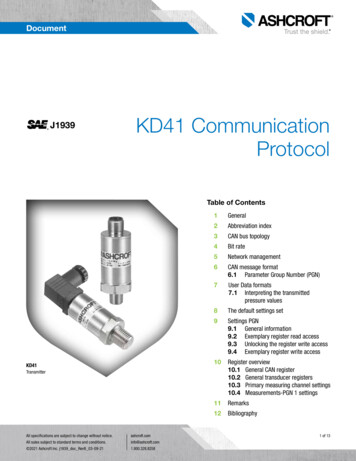
Transcription
Trust Standard for Assessment and Management of Physical Health PracticeGuidance NoteUrethral, Suprapubic and Intermittent Catherterisation – V04Date IssuedPlanned ReviewAMPH–PGN-04Issue 1 – Oct 2020Oct 2023Part of CNTW(C)29 – TrustStandard for Assessment andManagement of Physical HealthAuthor/Designation Sharon Gibson Clinical Nurse ManagerResponsibleOfficer /DesignationAnne Moore – Group Nurse ion12Guideline Scope13Aims14Indications for urethral catheterisation15Consent26Assessment for the need of urethral catheterisation27Catheter selection/Equipment38Suprapubic catheterisation49Intermittent self-catheterisation510Catheter Maintenance611Competence712Documentation813Removal of catheter914Education of patients and their carers915Monitoring915References9Cumbria, Northumberland, Tyne and Wear NHS Foundation TrustAMPH-PGN-04 – Urethral Suprapubic and intermittent catheterisation – V04-Iss1-Oct 2020Part of CNTW(C)29 - Trust Standard for assessment and management of Physical Health
Appendices – listed separate to PGNDocumentNo:DescriptionAppendix 1Nursing Assessment for Continence.Appendix 2Competency Assessment Document for Adult Catheterisation.Appendix 3Catheter History chartAppendix 4Urine Specimen collection (CSU)Appendix 5Emptying a urinary catheter bag.Appendix 6Competency Assessment Document for CISCCumbria, Northumberland, Tyne and Wear NHS Foundation TrustAMPH-PGN-04 – Urethral Suprapubic and intermittent catheterisation – V04-Iss1-Oct 2020Part of CNTW(C)29 - Trust Standard for assessment and management of Physical Health
AMPH-PGN-041IntroductionA urethral catheter is a hollow tube inserted into the urethra and retained in theurinary bladder for drainage, instillation of treatments or monitoring of urineoutput.Urethral catheter insertion is an invasive procedure that must only be carriedout when essential for individual patient care. The patient’s clinical need forcatheterisation must be reviewed regularly and the urinary catheter removedwhen no longer clinically required.Indwelling urinary catheters must be used only after alternative methods ofmanagement have been considered.2.Guideline ScopeUrethral catheter insertion is an invasive procedure that should only be carriedout when essential for individual patient care and only by a competent qualifiedpractitioner, using an aseptic non-touch technique (ANTT).3.AimThe aim of the competency is to ensure all patients receive a consistent andsafe standards of care during urinary catheterisation within CumbriaNorthumberland Tyne and Wear Trust.High impact Actions for Nursing and Midwifery (2020) advocated a dramaticreduction in the rate of UTI for patients in NHS provided care and cited that80% of UTIs occurring in hospitals can be traced to indwelling urinary catheters.The Cost Effective Commissioning for Continence Care (2011) reported thatannually there are 224,670 admissions for UTI (HES 2009-2010) and that thesehospital admissions are costly, increasing length of stay up to 9 days.In acute care facilities. The risk of developing bacteriuria increases 5% witheach day of catheterisation. Approximately 24% of bacteriuric patients willdevelop CAUTI, and of these up to 4% develop severe systemic infection(Loveday et al 2013).Therefore clinical staff must review the patient’s care need of a urinary catheterat least daily and remove promptly when clinically no longer required.4.Indications for urethral catheterisation Acute Urinary retention symptoms (voiding difficulties and renal protection)Chronic Urinary Retention.Neurological disease for short term use only (symptoms and renalprotection)1Cumbria, Northumberland, Tyne and Wear NHS Foundation TrustAMPH-PGN-04 - Urethral Suprapubic and intermittent catheterisation- V04-Iss1-Oct 2020Part of CNTW(C)29 - Trust Standard for assessment and management of Physical Health
AMPH-PGN-04 5.Facilitate continence and maintain skin integrity when all conservativemethods have failed.End of life care (comfort)ConsentCatheterisation is an invasive procedure with associated serious risks,therefore obtaining verbal valid consent is vital prior to the procedure and thisis to be clearly documented in patients RIO. In the patient who is unable to giveconsent, there must be a clearly stated rationale for using a catheter and it mustbe clear that this is in the best interests of the patient. There should be MDTinvolvement in this situation, and also evidence of consultation with appropriatenext of Kin.6Assessment for the need of urethral catheterisationDuring individual assessment, when bladder drainage is deemed necessary,consider the patients suitability for intermittent, suprapubic or urethralcatheterisation. (NICEGC171). A trust wide continence assessment tool isavailable (APPENDIX 1) and should be used for all patients with continenceissues.Factors to consider prior to catheterisation1. Is there an alternative, less invasive method of management (epic 2013)2. History of haematuria and or discharge3. Concomitant infection, potential need for antibiotic prophylaxis, discuss withnamed consultant4. History of urethral obstruction or previous difficult catheterisation5. History of recent surgery or malignancy to the lower urinary tract or previousgenital reconstruction surgery, for management of gender dysphoria.6. Congenital abnormalities affecting the pelvis7. History of fused labia or labial adhesions, presence of uterovaginal prolapse8. Trauma to the pelvis or abdomen9. Inflammation of the genito-urinary tract, cystitis, urethritis, vaginal pain10. Immunocompromised patients2Cumbria, Northumberland, Tyne and Wear NHS Foundation TrustAMPH-PGN-04 - Urethral Suprapubic and intermittent catheterisation – V04-Iss1-Oct 2020Part of CNTW(C)29 - Trust Standard for assessment and management of Physical Health
AMPH-PGN-0411. Catheterisation of patients who are agitated and/ cognitively impairedshould be carefully considered and risk assessed, due to the possibility ofdeliberate self-removal of catheter leading to tissue trauma.12. Spinal cord injured patients with risk of autonomic dysreflexiaIf the patient has any of the above concerns advice should be soughtfrom a suitably qualified and experienced practitioner working in theclinical area of urology, urognaecology7Catheter Selection / EquipmentWhen considering the approach to catheterisation and equipment selection, it isimportant to recognise that some individuals may have genital anatomy that isdifferent to their gender identity or stated / legal gender. Clinical decision aboutcatheterisation should be based on the anatomy of each person, not theirgender. However, a patient wishes regarding gender presentation, use ofpronouns etc, should be respected throughout.Urethral CatheterStandard packs would be used which include size 12CH, 14CH or 16CHcatheters.Latex free catheter to be used for patients with latex allergy. BARD ALLSILICONE FOLEY CATHETERS, Anaesthetic gel is not included in the catheterpack.Anaesthetic gelNational guidelines are ambivalent as to whether a lubricant gel or ananaesthetic gel should be used prior to catheterisation (RCN 2012). NICEadvises an appropriate lubricant should be used in all catheterisations.Anaesthetic gels which contain 2% lidocaine hydrochloride and chlorhexidinegluconate solution 0.25% anesthetises, has antiseptic properties and dilatesthe urethra thus reducing the risk of trauma and infection. Lubricating gel willonly dilate the urethra.CNTW staff will continue to use an anaesthetic gel when indicated. At least 11ml (male anatomy) or 6ml (female anatomy) of the gel is instilleddirectly into the urethra until this volume reaches the sphincter/bladder neckregion. The practitioner should wait 5 minutes after instilling the gel, beforestarting the catheterisation but it is important to follow manufacturer’sguidance. Anaesthetic gel must be prescribed.Do not use an anaesthetic gel if any of the following apply.3Cumbria, Northumberland, Tyne and Wear NHS Foundation TrustAMPH-PGN-04 - Urethral Suprapubic and intermittent catheterisation – V04-Iss1-Oct 2020Part of CNTW(C)29 - Trust Standard for assessment and management of Physical Health
AMPH-PGN-04 If allergic (hypersensitive) to lidocaine, chlorhexidine, methylhydroxybenzoate, propyl hydrobenzonate or any of the other ingredientsIf the moist lining of the application site is damaged or bleeding Care should betaken when using anaesthetic gel : If patients have heart problemsIf patients are epilepticIf patients have respiratory impairment If a serious adverse reaction occurs:Inform GP/dial 999Complete documentation and clinical incident as per Trust PolicyComplete a Yellow card as detailed in the BNFCatheters can either be intermittent, short/medium term (4 weeks), long term(12 weeks) or suprapubic See manufactures guidance in all packsCatheter sizeStandard pack available in sizes 12ch, 14ch or 16ch, suitable for both Male andFemale patientsBalloon sizeInstruction on the catheter packaging should be followedRoutine 10 ml sterile water pre filled syringe included in packAnaesthetic gel (Not included in Pack)If no risks apparent, slowly instil a lubricating/prescribed anaesthetic gelaccording to manufacturer’s instructions. If using Instillagel please wait 3-5minutes for the anaesthetic to take effect.Inflating the urinary catheter balloonOnly inflate the urinary catheter balloon having ensured that the urinary catheteris fully inserted into the urethra and is draining adequately. Slowly inflate theballoon according to manufacturer’s instructions. If the patient experiences painduring inflation of the balloon, stop inflation and reposition the catheter. If paincontinues seek medical advice immediately. If the urine cannot be drained oraspirated then remove the catheter and seek immediate expert advice.8.Suprapubic CatheterisationEAUN (2012) highlights several benefits to having a suprapubic catheter whencompared to a urethral catheter. These include Greater comfort, particularly for patients who are in a wheelchair.There is less risk of ureteral trauma, necrosis, or catheter induced urethritisand urethral strictures.Easier access to the cystostomy site for cleaning and catheter changes.4Cumbria, Northumberland, Tyne and Wear NHS Foundation TrustAMPH-PGN-04 - Urethral Suprapubic and intermittent catheterisation – V04-Iss1-Oct 2020Part of CNTW(C)29 - Trust Standard for assessment and management of Physical Health
AMPH-PGN-04 Reduced risks of catheter contamination with microorganisms that’s artecommonly found in the bowel, therefore reducing the risk of urinary tractinfections.Enables the patient to remain or be sexually active.Micturition is still possible if ureteral not surgically closed or obstructed.To reduce infection in the supra pubic site, always ensure good hand hygieneis performed prior to any intervention, and ensure an aseptic technique isfollowed during catheter changes.National guidelines recommend that daily cleansing of the site with soap andwater is all that is required as excess cleansing may increase the risk ofinfection EAUN, (2012)Changing a suprapubicFollowing the initial insertion of a suprapubic catheter, the catheter must stay inplace for up to 4 to 6 weeks. This allows time for the tract to become establishedEAUN (2012)The first change of the catheter must be done in a hospital setting without delayso that the cystostomy is not allowed to close. A subsequent change, when thecystostomy is established, is not so critical but does need to be carried outimmediately after the old catheter is removed.Most uncomplicated catheter changes can take place in the patient’s own homeor ward environment.Training and experience in changing a suprapubic catheter is essential.Only appropriately trained staff should undertake a suprapubic change.On insertion of the catheter, advance the catheter in to the tract 3cm deeperthan the removed catheter. If no urine drains, gently apply pressure on thesymphysis pubic area. Once urine starts to drain, slowly inflate the catheterballoon according to the manufactures instructions. Withdraw the catheterslightly and attach the drainage bag and secure with the appropriate straps(EAUN 2012)Dressings are often unnecessary and are best avoided, if is dressing is used tocontain discharge from the site, this should be undertaken with strict aspecttechnique to protect against infection.A care plan for bladder management / catheter care should be available andclear written documentation should be maintained. A fluid balance chart shouldbe maintained for all inpatients.5Cumbria, Northumberland, Tyne and Wear NHS Foundation TrustAMPH-PGN-04 - Urethral Suprapubic and intermittent catheterisation – V04-Iss1-Oct 2020Part of CNTW(C)29 - Trust Standard for assessment and management of Physical Health
AMPH-PGN-049.Intermittent self-catheterisationIntermittent catheterisation may be a short or long term intervention. It hasbeen identified as the optimal treatment for persons with chronic urinaryretention or incomplete emptying of the bladder (RCN, 2019). Ideally patientsshould be taught CISC once and supervised in undertaking the procedure untilthe practitioner feels confident.The procedure involves the episodicintroduction of a catheter into the bladder to remove urine. Once the bladder isempty the catheter is removed, leaving the patient catheter free betweencatheterisations. The patient should perform catheterisation as often asnecessary to prevent incontinence or prolonged retention of urine. CleanIntermittent Self Catheterisation (CISC) is performed by the individual,Intermittent cathertersation (IC) is performed by a competent Healthcareprofessional, carer or family member.10.Catheter MaintenanceThe most common complications that occur are urinary tract infection (UTI) andcatheter blockage, which can affect up to 70% of catheterised patients.1,9Blockage, in turn can lead to leakage, or bypassing of urine and discomfort andembarrassment for the patient.Selecting the right solutionFollowing diagnosis of the catheter problem the correct solution can be chosen.If the blockage is due to debris, as a first line URO –Tainer NaCl 0.9% can beused. If the blockage is due to encrustation, URO tainer Suby G may be usedto reduce/ dissolve the encrustation (Braun 2019)Braun Uro-Tainer NaCI 0.9%Indication: This isotonic fluid is used primarily for cleaning the bladder andcatheters mechanically, e.g. in the case of debris formation in the bladder.Recommend rinse frequency: 1 to 2 times per day depending on the scope ofthe problem, unless prescribed differently by the doctor.Uro-Tainer Twin SUBY GTwin bag for a superior efficacy in dissolving / reducing encrustations thanks to2 sequential instillationsKinder in use due to smaller volumesHigher patient's quality of lifeSuby G to be prescribed by medical staff and can be administered 1-2 timesper day.All catheter bags should be emptied when two thirds full. See Appendix 5 forguidance on how to empty a catheter bag. Change drainage bags whenclinically indicated in line with manufacturer’s recommendations and documentin the patient’s notes/RioTraining available for maintenance of catheter and catheter care.6Cumbria, Northumberland, Tyne and Wear NHS Foundation TrustAMPH-PGN-04 - Urethral Suprapubic and intermittent catheterisation – V04-Iss1-Oct 2020Part of CNTW(C)29 - Trust Standard for assessment and management of Physical Health
AMPH-PGN-04Collecting a urine sample (CSU)Following clinical assessment, if a patient has symptoms indicating a urineinfection a CSU should be taken to determine the cause of infection. Urinesamples must be obtained using an aseptic technique form a catheter samplingport and only if Clinical indication of infection is presentThe patient is not responding to antibiotic treatmentSee Appendix 4 for guide in how to obtain a CSU.11.CompetenceInserting a urinary catheter should only be carried out by a registered, qualifiedhealthcare professional who can demonstrate that they have received suitabletraining or instruction and deemed competent under the NMC Code (NMC,2016), General Medical Council (GMC, 2006) or the Health Professions Council(HPC London).Competency for urinary and intermittent catheterisation The registered, qualified healthcare professional should not undertakethese procedure until they are assessed and deemed competent. Until suchtime this procedure should be undertaken as part of supervised trainingwith a suitable competent, registered, qualified doctor, nurse or healthcareprofessional.The registered, qualified healthcare professional needs to be familiar withTrust equipment and guidelines.Senior supervision should be available if required.To gain competence the following practice recommendations should bemet. Gain theoretical knowledge and understanding in aspects of catheterisation.Observe model/manikin being catheterised.Practice catheterisation on a model/ manikin under supervision untilconfident using ANTTObserve catheterisation performed by others on an actual patient usingANTTUndertake supervised catheterisation on an actual patient using ANTTBe able to catheterise without direct supervisionGain experience and become confidentTo maintain competence you must keep up to date with new knowledge andchanges to procedures.7Cumbria, Northumberland, Tyne and Wear NHS Foundation TrustAMPH-PGN-04 - Urethral Suprapubic and intermittent catheterisation – V04-Iss1-Oct 2020Part of CNTW(C)29 - Trust Standard for assessment and management of Physical Health
AMPH-PGN-04Competency assessment documents (Appendix 2 catheterisation andAppendix 6 Intermittent catheterisation) to be completed and signed by off bycompetent practitioner declaring individual competence with approved level ofknowledge and skill. There is no minimum or maximum number of times thequalified/ registered practitioner should carry out this skill under supervisionbefore deemed competent. This will be based on the judgement of theassessor.Catheterisation and care of the catheter to be discussed in clinical supervisionand reflective practice to be utilised.12.DocumentationA record of the catheterisation must be made in the patient record/Rio careplan. The information must follow the NMC (2020) The Code and include: Reason(s) for catheterisation or continued catheterisationDate and time of catheterisationType of catheter used, (calibre, length, balloon size, material, batch numberand manufacturer)Cleansing solution (normal saline) or in the community (soap and water)andlubricant/anaesthetic agent usedThe single use anaesthetic gel must be prescribed by a competentregistered nurse/doctor or supplied to the patient by a registered nurseunder a Patient Group Direction. This becomes the patient’s own medicationwhich can then be handed to the Nurse/Midwife/Assistant Practitioner foradministration to the patient.Amount and expiry date of the prescribed anaesthetic gel usedProblems encountered during procedurePresence and amount of immediate urine drainageDate, place and personnel for next re-assessment, catheter change orremovalType of drainage equipment used and date when it is required to bechangedDocument catheter blockages and any trauma during catheterisationSignature of the practitioner who carried out the catheterisationCatheter History chart (Appendix 3) can be used to support RIO care plan.13.Removal of catheterA trial without catheter (TWOC) should be considered at the earliestopportunity.Suitability for TWOC must be taken in to account (medical status, infectionhistory, antibiotic indications, and patient’s ability to consent.Cautions when assessing for TWOC include Presence of large urogenital prolapse8Cumbria, Northumberland, Tyne and Wear NHS Foundation TrustAMPH-PGN-04 - Urethral Suprapubic and intermittent catheterisation – V04-Iss1-Oct 2020Part of CNTW(C)29 - Trust Standard for assessment and management of Physical Health
AMPH-PGN-04 Previous failed TWOCAny surgery for stress incontinenceMedications (anticholinergics)Large fibroid uterusCatheter valveA catheter valve is like a tap which fits directly into the end of the indwellingcatheter. The valve is an alternative to the catheter drainage bag. The valveallows the bladder to continue being used maintaining normal function and isdiscreet.The valve should be changed every 5-7 days and catheter bags can beattached at night on continual drainage. These are not recommended for thosepatients who have over active bladder. Catheter valves are fitted using thesame technique as leg bags.Planned removal of catheter should be discussed with patient, medical staff andif appropriate family / next of kin. A care plan should be developed in partnershipwith the patient setting out the clear wishes of the patient as well as adocumented plan of the removal of catheter looking at suitability and potentialrisk factors.Following the removal of the catheter it is best practice that three post voidbladder scans are completed to ensure the patient is not in urinary retention. Ifa bladder scanner is not available strict monitoring of fluid balance should bemaintained, to ensure patient is passing urine adequately.14.Education of patients and their carers:Patients and carers should be educated and trained in the techniques of handdecontamination and catheter care before being discharged from hospital.No patient should be discharged or transferred with a short term indwellingurethral catheter without a plan documenting the: Reason for the catheterClinical indications for continuing catheterisationDate for removal or review by an appropriate clinician overseeing their carePrior to discharge home all patients who are leaving hospital with a long termcatheter should have a referral made to district nursing team and continenceaid provider to ensure equipment available on discharge.15.MonitoringAll patient with catheters and patients who have been diagnosed with UrinaryTract infections (UTI) should be recorded on the Safety thermometer. All UTI’s9Cumbria, Northumberland, Tyne and Wear NHS Foundation TrustAMPH-PGN-04 - Urethral Suprapubic and intermittent catheterisation – V04-Iss1-Oct 2020Part of CNTW(C)29 - Trust Standard for assessment and management of Physical Health
AMPH-PGN-04should be incident reported and investigated at ward level and discussed aspart of medical review.16.References Braun 2019 Catheter Maintenance with URO –Tainer – Improving PatientQuality of Life. Edition 8, Sheffield, UKBritish Association of Urological Nurses (2010) Clean IntermittentCatheterisation: The Patient JourneyEuropean Association of Urology Nurses (EAUN) 2012. Catheterisation.Indwelling catheters in Adults – Urethral and Suprapubic, Arnhem. Netherlands.General Medical Council. 2006 GMC LondonHealth Protection Agency, English national point prevalence survey onhealthcare associated infections and antimicrobial use (2012)Loveday, H.P et al (2013) Epic 3: Journal of Hospital Infection December 201386S1:S1-S70NMC (2020) The Code NMC, LondonNICE Guidelines number 139 (2017) Healthcare-associated infections:prevention and control in primary and community care.NICE (2012) Urinary incontinence in Neurological disease: Managementof lower urinary tract Dysfunction in neurological diseaseNICE (2010) Lower urinary tract symptoms in men: managementPrieto, J., Murphy, C.L., Moore, K.N. and Fader, M. (2014) 'Intermittentcatheterisation for long-term bladder management', Cochrane Database SystRev, 9, p. /14651858.CD006008.pub3/full accessed8.10.2020Rowley, S., Clare S, and Macqueen, S. et al (2010). ‘ANTTv2: An updatedpractice framework for aseptic technique. ’ British Journal of Nursing(Intravenous Supplement). Vol 19,5, S5-S12RCN (2019) Catheter Care RCN guidance for nursesRoyal College of Nursing Catheter Care RCN Guidance for Nurses (2019)The Royal Marsden Manual of Clinical Nursing Procedures. 9th edition,Blackwell ScienceSkills for HealthLinks to Skill for Health (RCN, 2019)Assess bladder and bowel dysfunctionCare for individuals with urethral cathetersEnable individuals to carry out intermittent catheterisationReview Catheter careCare for individuals using containment productsHelp Individuals to effectively evacuate their bowelsAssess residual urine by using ultrasoundCC01CC03CC06CC07CC08CC09CC1010Cumbria, Northumberland, Tyne and Wear NHS Foundation TrustAMPH-PGN-04 - Urethral Suprapubic and intermittent catheterisation – V04-Iss1-Oct 2020Part of CNTW(C)29 - Trust Standard for assessment and management of Physical Health
Oct 1, 2020





